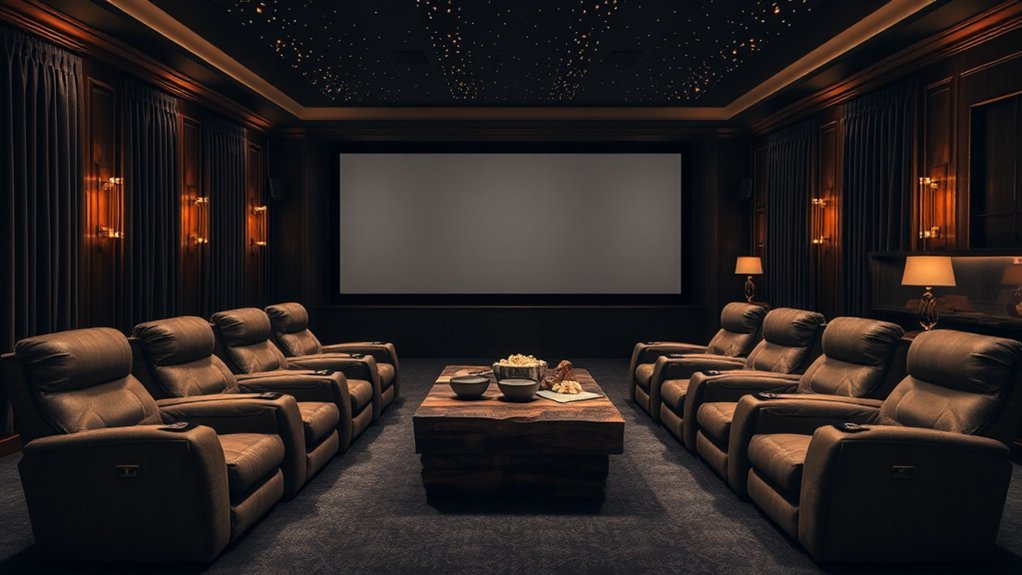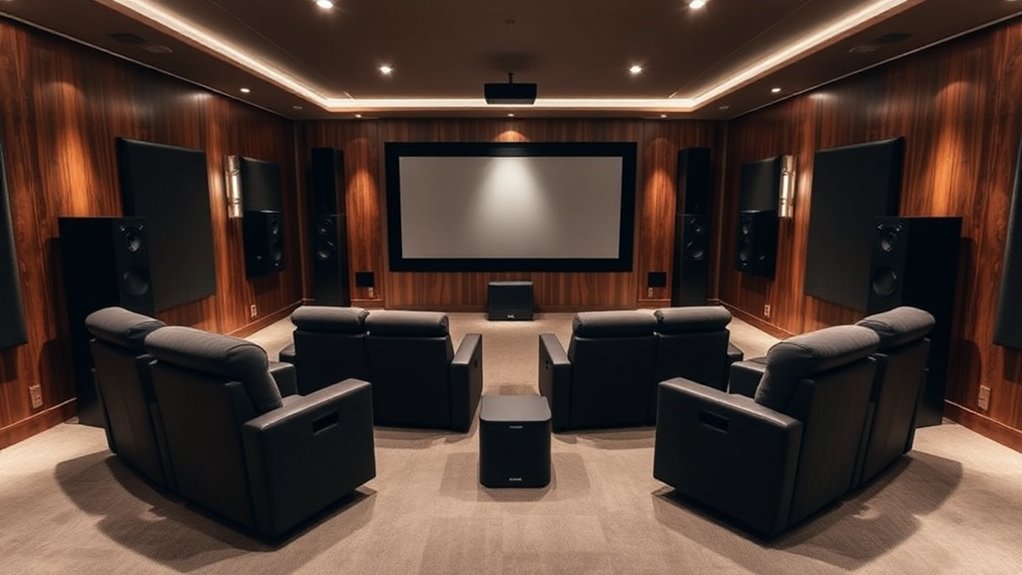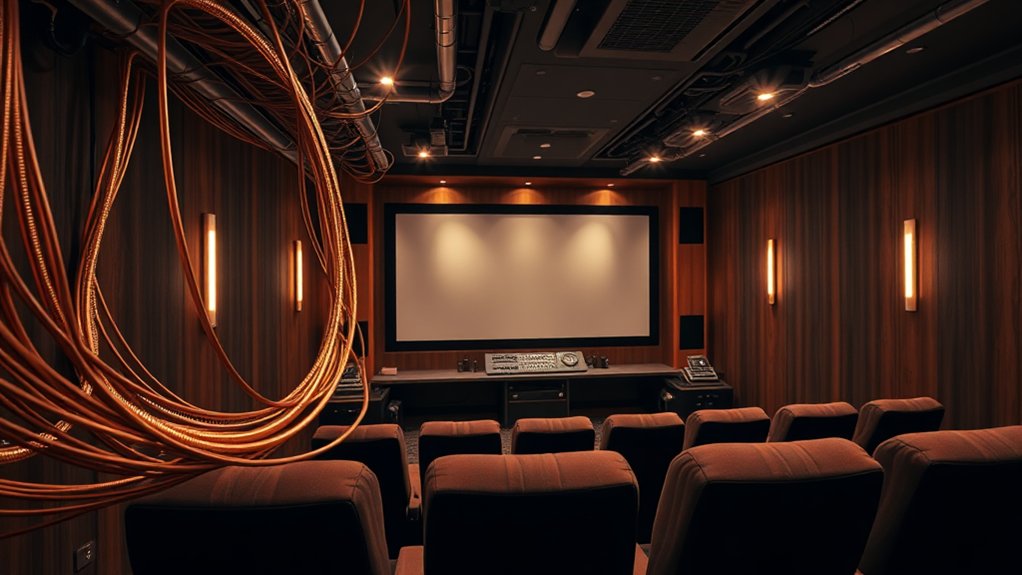To achieve the perfect theater room vibe, you’ve got to carefully consider your furniture placement. First, angle your seats towards the screen—it’ll create better sightlines and immersion. Next, think about spacing; maintaining a minimum of 20 inches between rows keeps things comfortable and avoids awkward traffic jams. Don’t forget to stagger your seating for unobstructed views, and align your audio-visual equipment at ear level for ideal sound. Want to uncover even more tips? Keep going!
Key Highlights
- Angle seating toward the screen to optimize sightlines and enhance the immersive viewing experience.
- Implement tiered seating with 12 to 16 inch risers to ensure unobstructed views for all rows.
- Maintain at least 20 inches of clearance between seating rows for comfort and easy movement.
- Position speakers at ear level and ensure the screen is at eye level to enhance audio-visual quality.
- Choose furniture that balances aesthetics and comfort, avoiding overcrowding in smaller spaces.
Optimal Seating Arrangement for Sightlines
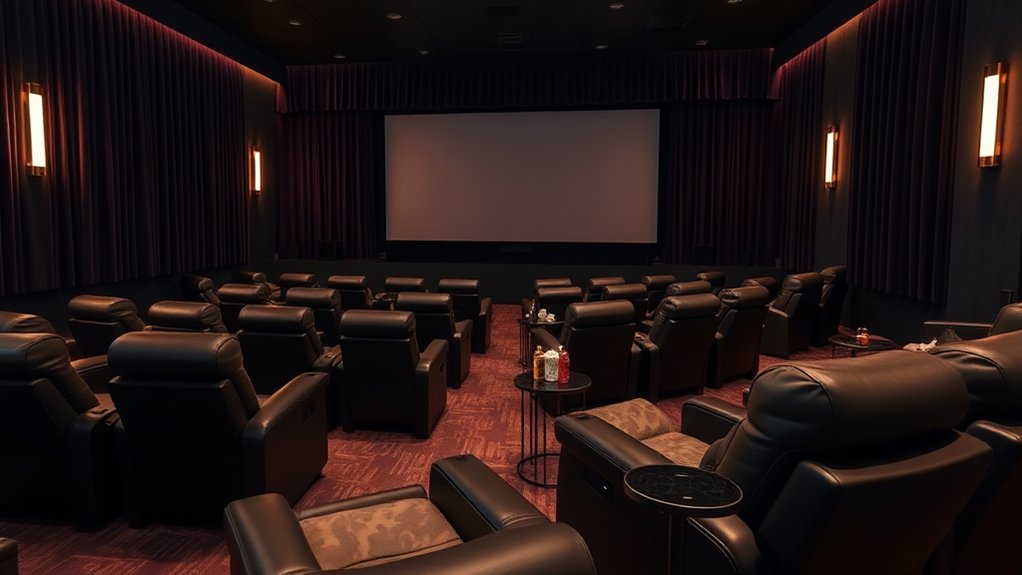
When considering the ideal seating arrangement for your theater room, have you ever wondered how to guarantee everyone has an unobstructed view of the screen?
Start by angling the seats slightly toward the screen, improving direct lines of sight. If you’ve got multiple rows, tiered seating becomes essential—after all, no one wants a tall friend blocking the show, right? Aim for riser heights around 12 to 16 inches, ensuring the back rows can see over the front comfortably. Additionally, ensure that your seating arrangement allows for minimum recommended distance between rows to enhance comfort and accessibility. To further improve the experience, it’s crucial to maintain clear traffic flow around the seating areas, allowing for easy movement without disruptions.
Avoid placing rows directly behind one another at the same height, as this can lead to obstructions. Staggering rows or using curved layouts helps maintain sightlines as well as keeping that immersive feel you want from a home theater.
Space Considerations for Comfortable Passage
Setting up a theater room isn’t just about picking the right screen size or plush seating; it’s crucial to reflect on the space you’re working with to guarantee comfortable passage for everyone involved. Aim for a minimum room width of 15 feet, leaving at least 20 inches of clearance around seating rows. You wouldn’t want guests squeezed like sardines, right? Keep aisle widths at 20 inches, too, allowing easy access without gymnastics. A rectangular room shape helps optimize both space and acoustics, and avoiding obstructive corner furniture can maintain safe walkways. Additionally, ensure that you provide enough space for home theater equipment to avoid overcrowding and to enhance the overall viewing experience. Finally, remember to evaluate ceiling height and furniture scale—after all, nobody wants to trip over a chair or navigate a maze just to get popcorn. Assessing the size of furniture in relation to your theater room will also contribute to a more enjoyable layout.
Focal Point Alignment for Immersive Viewing
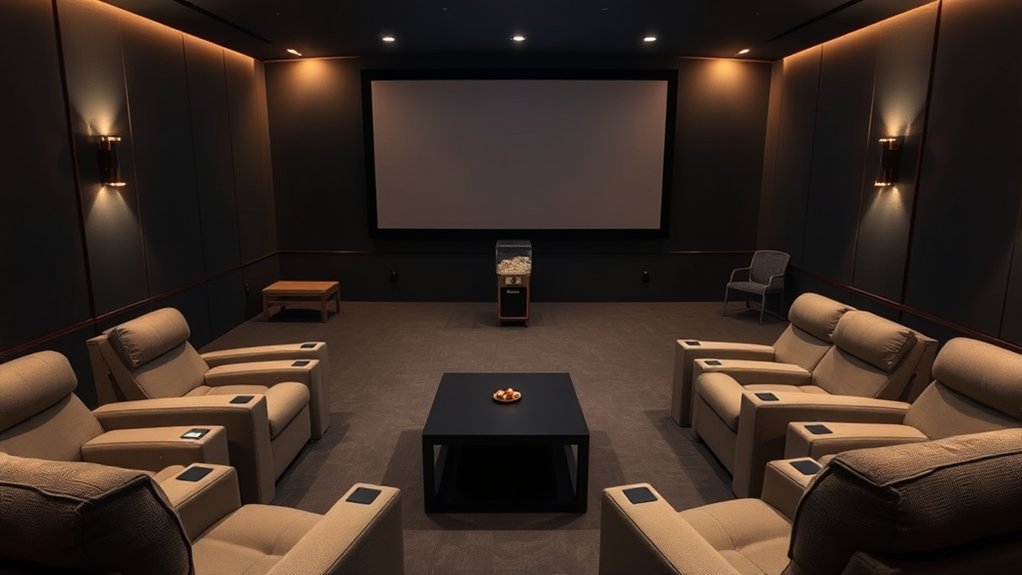
With comfortable passage established, it’s time to focus on how you align your theater room’s focal point for an immersive viewing experience.
The screen or projection area serves as your primary focal point, so arrange seating without obstructions—no one likes a head in their line of sight! Aim for seating angles that target the screen’s center, maximizing immersion and reducing any neck strain. Additionally, consider implementing sight line principles to ensure that all viewers can comfortably see the screen without any distractions.
Stagger rows for improved sight lines; raised back rows work wonders, too. Confirm no competing focal points, like a fireplace, detract from the screen. Instead, amplify its presence with strategic lighting or complementary décor.
Balancing Furniture Scale and Proportion
Achieving the right balance of furniture scale and proportion in your theater room isn’t just a matter of luck; it requires careful consideration of the space you have.
Start by measuring your room’s dimensions—length, width, and height are foundational for choosing appropriate furniture. For instance, if you’ve got a cozy space, overstuffed sofas might feel like they’re squatting instead of sitting.
Measuring your room’s dimensions is crucial; the wrong furniture scale can overwhelm a cozy space.
In rooms with high ceilings, tall furniture can draw the eye upward, concurrently low-profile seating works wonders in smaller areas.
Always think about circulation space—nobody wants to navigate a maze of chairs during reaching for popcorn!
Plus, coordinating your furniture with fixed architectural elements can improve both the look and feel of your theater.
Enhancements for Functional Comfort
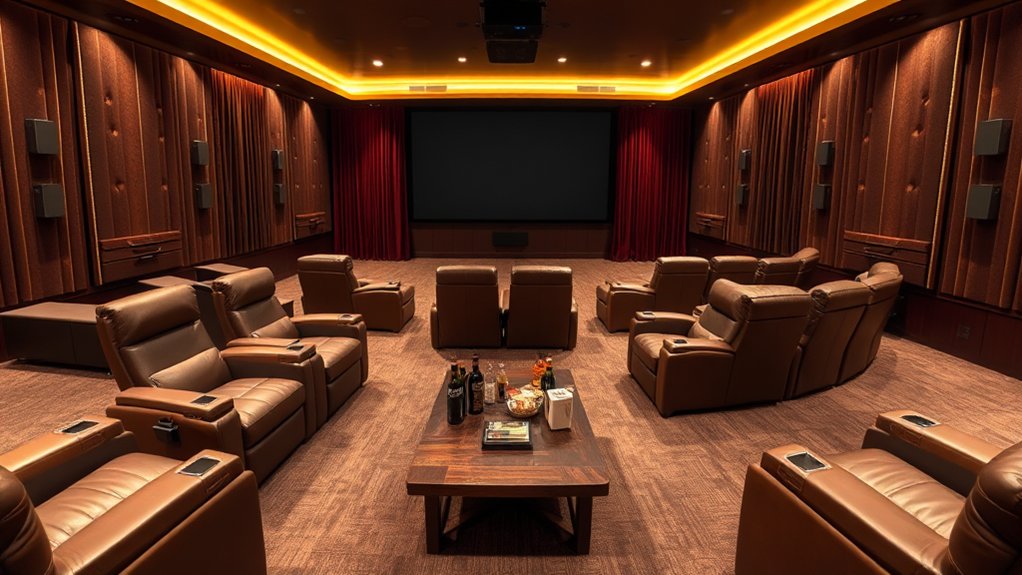
Regarding enhancing functional comfort in your theater room, selecting the right seating is more than just a preference—it’s a vital step towards a truly enjoyable viewing experience.
First off, welcome ergonomic seating with memory foam or high-density cushions that support your neck and lower back, like a supportive hug during arduous movie marathons. Adjustable backrests and leg supports allow you to customize your posture, ensuring you won’t feel like a pretzel halfway through.
Consider using high-quality materials—think durable leather or breathable fabrics that regulate temperature—because who wants to swelter in excitement?
Finally, arrange your seating to promote clear sightlines, so you won’t have to channel your inner owl, twisting and turning for a better view. Comfort should never be secondary!
Audio-Visual Placement for Optimal Experience
As you’re settling into the perfect seating arrangement that makes you feel like royalty during movie nights, don’t overlook the audio-visual setup, which is just as important for that immersive experience.
Start by placing your front left, center, and right speakers at ear level and equidistant from your seating for balanced sound. Surround speakers should be positioned slightly above ear height, enhancing that cinematic surround effect.
Don’t forget those Dolby Atmos speakers—placing them near the front and rear helps create a rich overhead audio experience. To elevate your audio setup, consider incorporating a system like the Sony HT-S40R, which offers true 5.1 channel surround sound and enhances your movie viewing.
For your screen, make certain it’s at eye level to prevent neck strain, and keep your seating aligned for ideal viewing.
After all, what’s a movie night without breathtaking sound and video?
Incorporating Acoustics in Seating Design
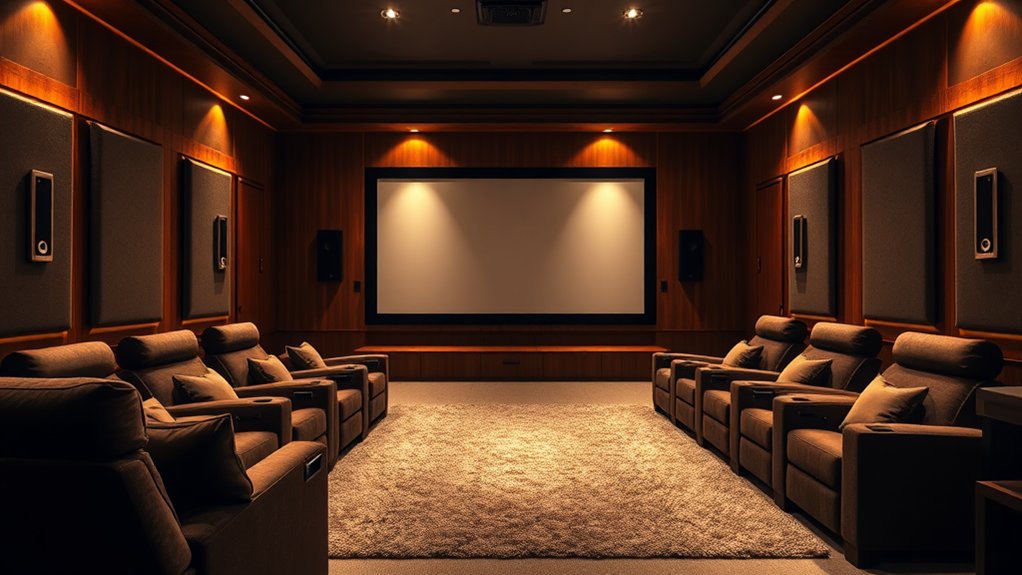
Designing a theater room isn’t just about picking the coziest seats; it’s furthermore about ensuring those seats contribute to a phenomenal audio experience.
You’ll want to choose soft fabric materials like microfiber or velour, which absorb sound better than leather, minimizing echoes and enhancing clarity.
Positioning is just as essential—align your seats to evenly receive sound waves as you avoid hard reflective walls.
Don’t forget to complement your seating with plush rugs or carpeting, which help absorb residual noise, muffling footfalls.
Integrating acoustic panels and bass traps with your comfy seating creates that dream sound environment.
After all, nobody wants to hear their neighbor’s popcorn crunch during a quiet scene, right?
Managing Traffic Flow and Accessibility
How can you create a theater room that’s both comfortable and easy to navigate? Start by ensuring clear pathways, maintaining at least a 36-inch aisle width. This not only allows for smooth movement but additionally keeps seated viewers undisturbed.
Position aisles strategically to provide easy access to exits, and arrange your seating so viewers can enter without crossing in front of others—because who enjoys being “that person”? Entrances should be conveniently located, with wide doorways to handle expected traffic, whereas lighting can help highlight pathways and emergency exits.
Finally, consider mobility needs; allocate extra space for wheelchairs, and opt for non-slip flooring to keep everyone safe. After all, a great film shouldn’t come with a potential trip hazard!
Frequently Asked Questions
What Types of Seating Materials Are Best for Home Theater Comfort?
For home theater comfort, consider leather for durability and easy cleaning, or opt for soft fabrics like microfiber that improve acoustics. Each material offers unique benefits, so choose what best fits your needs and preferences.
How Can Lighting Affect the Overall Viewing Experience in Theater Rooms?
Lighting considerably impacts your viewing experience, reducing eye strain and enhancing immersion. By adjusting color temperature and placement, you create a comfortable atmosphere that complements your film’s mood and preventing distractions from glare or harsh contrasts.
Are There Recommendations for Soundproofing a Theater Room Effectively?
To soundproof your theater room effectively, combine heavy materials for mass, decouple surfaces, and use sound-absorbing insulation. Ascertain you seal gaps and consider specialized doors and windows to minimize sound leakage throughout the space.
What Additional Furniture Can Enhance the Aesthetics of a Theater Room?
To improve your theater room’s aesthetics, consider adding woven rugs for softness, rounded accent tables for practicality, vintage decor for contrast, and personalized acoustic panels that double as art, enriching both style and sound quality.
How Do Different Screen Sizes Influence Furniture Placement Decisions?
Different screen sizes directly influence your furniture placement decisions. Larger screens require more distance between seating, whereas smaller screens allow for closer arrangements. Always consider comfort, sightlines, and room dimensions when planning your layout.

